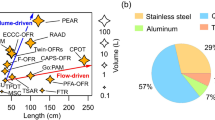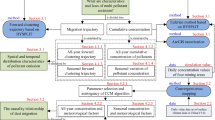Abstract
Generally, coal is rich in boron (B) and has distinctive negative δ11B values. In this study, we aim to evaluate the extent to which emissions from coal combustion facilities affect the atmospheric concentration and δ11B of particulate B in their surrounding environment. We analyzed the variations in atmospheric concentration and δ11B of particulate B observed over 2 years at three sites (Kakogawa, Nishio, and Komae) in urban and industrial areas, including major coal-fired power plants and iron works, in Japan, and at one site (Betsukai) in a background area as a reference. At all the sites, the particulate B concentration increased during winter and decreased during summer, and the particulate B concentration tended to increase with decreasing atmospheric temperature at temperatures lower than approximately 18 °C. Thus, the increase in particulate B concentration during winter may be attributable primarily to the enhanced condensation of gaseous B on atmospheric particles owing to low temperatures. On the other hand, the seasonal changes in the δ11B of particulate B at the urban and industrial sites were opposite to those in the particulate B concentration. The urban and industrial sites had higher particulate B concentrations than the background site and negative δ11B values, which are characteristic of coal, during winter. This shows that particulate B at the urban and industrial sites is strongly affected by emissions from coal combustion facilities during winter. Moreover, using the Pb/Zn ratio of aerosols, we determined whether particulate B originates from coal combustion in Japan or China.







Similar content being viewed by others
Data Availability
The authors confirm that the data used in this study are available from the corresponding author on reasonable request.
References
Agency of Natural Resources and Energy (2018). https://www.enecho.meti.go.jp/about/whitepaper/2018html/2-1-3.html.
Anderson, D. L., Kitto, M. E., McCarthy, L., & Zoller, W. H. (1994). Sources and atmosphere distribution of particulate and gas phase boron. Atmospheric Environment, 28(8), 1401–1410. https://doi.org/10.1016/1352-2310(94)90203-8.
BP Statistical World Review of World Energy (2018). https://www.bp.com/en/global/corporate/energy-economics/statistical-review-of-world-energy/coal.html.
Chetelat, B., & Gaillardet, J. (2005). Boron isotopes in the Seine River, France: A probe of anthropogenic contamination. Environmental Science and Technology, 39(8), 2486–2493. https://doi.org/10.1021/es048387j.
Chetelat, B., Gaillardet, J., Freydier, R., & Négrel, Ph. (2005). Boron isotopes in precipitation: Experimental constraints and field evidence from French Guiana. Earth Planetary Science Letter, 235(1–2), 16–30. https://doi.org/10.1016/j.epsl.2005.02.014.
Chetelat, B., Gaillardet, J., & Freydier, R. (2009). Use of B isotopes as a tracer of anthropogenic emissions in the atmosphere of Paris France. Applied Geochemistry, 24(5), 810–820. https://doi.org/10.1016/j.apgeochem.2009.01.007.
Devidson, G. R., & Bassett, R. L. (1993). Application of boron isotopes for identifying contaminants such as fly ash leachate in groundwater. Environmental Science and Technology, 27(1), 172–178. https://doi.org/10.1021/es00038a020.
European Environmental Agency (2017). Coal-fired power plants remain top industrial polluters in Europe. https://www.eea.europa.eu/highlights/coal-fired-power-plants-remain.
Fogg, T. R., & Duce, R. A. (1985). Boron in the troposphere: Distribution and fluxes. Journal of Geophysical Research, 90(D2), 3781–3796. https://doi.org/10.1029/JD090iD02p03781.
Foster, G. L., Pogge von Strandmann, P. A. E., & Rae, J. W. B. (2010). Boron and magnesium isotopic composition of seawater. Geochemistry, Geophysics, Geosystems, 11(8). https://doi.org/10.1029/2010GC003201.
Gladney, E. S., Wangen, L. E., Curtis, D. B., & Jurney, E. T. (1978). Observations on boron release from coal-fired power plants. Environmental Science and Technology, 12(9), 1084–1085. https://doi.org/10.1021/es60145a015.
Hioki, T., Kimoto, T., Hasegawa, S., Mukai, H., & Ohara, T. (2009). Analysis of long-range transported and local air pollution with trace metal concentration ratio in aerosols collected at Matsuyama, Osaka and Tsukuba, Japan. Journal of Japanese Society of Atmospheric Environment, 44(2), 91–101. (in Japanese).
Japan Meteorological Agency. http://www.data.jma.go.jp/obd/stats/etrn/index.php.
Mather, J. D., & Porteous, N. C. (2001). The geochemistry of boron and its isotopes in groundwaters from marine and non-marine sandstone aquifers. Applied Geochemistry, 16(7–8), 821–834. https://doi.org/10.1016/S0883-2927(00)00072-X.
Miyata, Y., Tokieda, T., Amakawa, H., Uematsu, M., & Nozaki, Y. (2000). Boron isotope variations in the atmosphere. Tellus, 52B(4), 1057–1065. https://doi.org/10.3402/tellusb.v52i4.17083.
Mukai, H., Ambe, Y., Shibata, K., Muku, T., Takeshita, K., Fukuma, T., Takahashi, & Mizota, S. (1990). Long-term variation of chemical composition of atmospheric aerosol on the Oki Islands in the Sea of Japan. Atmospheric Environment, 24(6), 1379–1390. https://doi.org/10.1016/0960-1686(90)90044-N.
Mukai, H., Tanaka, A., & Fujii, T. (1994). Lead isotope ratios of airborne particulate matter as tracers of long-range transport of air pollutants around Japan. Journal of Geophysical Research, 99(D2), 3717–3726. https://doi.org/10.1029/93JD02917.
Nir, O., Vengosh, A., Harkness, J. S., Dwyer, G. S., & Lahav, O. (2015). Direct measurement of the boron isotope fractionation factor: Reducing the uncertainty in reconstructing ocean paleo-pH. Earth and Planetary Science Letters, 414(1), 1–5. https://doi.org/10.1016/j.epsl.2015.01.006.
Okuda, T., Kato, J., Mori, J., Tenmoku, M., Suda, Y., Tanaka, S., He, K., Ma, Y., Yang, F., Yu, X., Duan, F., & Lei, Y. (2004). Daily concentrations of trace metals in aerosols in Beijing, China, determined by using inductively coupled plasma mass spectrometry equipped with laser ablation analysis, and source identification of aerosols. Science of the Total Environment, 330(1–3), 145–158. https://doi.org/10.1016/j.scitotenv.2004.04.010.
Park, H., & Schlesinger, W. H. (2002). Global biogeochemical cycle of boron. Global Biogeochemical Cycles, 16(4), 1072. https://doi.org/10.1029/2001GB001766.
Rose, E. F., Carignan, J., & Chaussidon, M. (2000). Transfer of atmospheric boron from the oceans to the continents: An investigation using precipitation waters and epiphytic lichens. Geochemistry, Geophysics, Geosystems, 1(11), 2000GC000077. https://doi.org/10.1029/2000GC000077.
Rose-Koga, E. F., Sheppard, S. M. F., Chaussidon, M., & Carignan, J. (2006). Boron isotopic composition of atmospheric precipitations and liquid-vapour fractionations. Geochimica Et Cosmochimica Acta, 70(7), 1603–1615. https://doi.org/10.1016/j.gca.2006.01.003.
Roux, P., Turpault, M.-P., Kirchen, G., Redon, P.-O., & Lemarchand, D. (2017). Boron dissolved and particulate atmospheric inputs to a forest ecosystem (northeastern France). Environmental Science and Technology, 51(24), 14038–14046. https://doi.org/10.1021/acs.est.7b03226.
Sakata, M., & Marumoto, K. (2004). Annual changes in wet deposition fluxes of trace metals and scavenging of mercury by precipitation in the western Tokyo metropolitan area. Journal of Environmental Chemistry, 14(3), 555–565. (in Japanese).
Sakata, M., Natsumi, M., & Tani, Y. (2010). Isotopic evidence of boron in precipitation originating from coal burning in Asian continent. Geochemical Journal, 44(2), 113–123. https://doi.org/10.2343/geochemj.1.0049.
Sakata, M., Ishikawa, T., & Mitsunobu, S. (2013). Effectiveness of sulfur and boron isotopes in aerosols as tracers of emissions from coal burning in Asian continent. Atmospheric Environment, 67, 296–303. https://doi.org/10.1016/j.atmosenv.2012.11.025.
Sakata, M., Ishikawa, T., & Mitsunobu, S. (2014). Contribution of Asian outflow to atmospheric concentrations of sulfate and trace elements in aerosols during winter in Japan. Geochemical Journal, 48(5), 479–490. https://doi.org/10.2343/geochemj.2.0323.
Sakata, M., Phan, H. G., & Mitsunobu, S. (2017). Variations in atmospheric concentrations and isotopic compositions of gaseous and particulate boron in Shizuoka City, Japan. Atmospheric Environment, 148, 376–381. https://doi.org/10.1016/j.atmosenv.2016.11.013.
Sakata, M., Suzuki, R., & Marumoto, K. (2021). Evaluation of long-term trend of atmospheric lead pollution in western Japan based on lead isotope ratios and Pb/Zn ratio of aerosols effective even today as indicators of long-range transport of aerosols from the Asian continent. Environmental Monitoring and Contaminants Research, 1, 37–46. https://doi.org/10.5985/emcr.20200003.
Tian, H. Z., Zhu, C. Y., Gao, J. J., Cheng, K., Hao, J. M., Wang, K., Hua, S. B., Wang, Y., & Zhou, J. R. (2015). Quantitative assessment of atmospheric emissions of toxic heavy metals from anthropogenic sources in China: Historical trend, spatial distribution, uncertainties, and control policies. Atmospheric Chemistry and Physic, 15(17), 10127–10147. https://doi.org/10.5194/acp-15-10127-2015.
Williams, L. B., Hervig, R. L., Wieser, M. E., & Hutcheon, I. (2001). The influence of organic matter on the boron isotope geochemistry of the gulf coast sedimentary basin, USA. Chemical Geology, 174(4), 445–451. https://doi.org/10.1016/S0009-2541(00)00289-8.
Williams, L. B., & Hervig, R. L. (2004). Boron isotope composition of coals: A potential tracer of organic contaminated fluids. Applied Geochemistry, 19(10), 1625–1636. https://doi.org/10.1016/j.apgeochem.2004.02.007.
Zhao, Z.-Q., & Liu, C.-Q. (2010). Anthropogenic inputs of boron into urban atmosphere: Evidence from boron isotopes of precipitations in Guiyang City China. Atmospheric Environment, 44(34), 4165–4171. https://doi.org/10.1016/j.atmosenv.2010.07.035.
Acknowledgements
Aerosol sampling was conducted by the Central Research Institute of Electric Power Industry, where M.S. was a research scientist, under contract with the Ministry of Economy, Trade, and Industry in the fiscal year 2002–2006.
Author information
Authors and Affiliations
Contributions
Y.T. conducted the experimental work and data analysis with the supervision from M.S. Y.T. drafted the manuscript, and M.S. provided comments and revisions based on that.
Corresponding author
Ethics declarations
Conflict of Interest
The authors declare no competing interests.
Additional information
Publisher's Note
Springer Nature remains neutral with regard to jurisdictional claims in published maps and institutional affiliations.
Rights and permissions
About this article
Cite this article
Sakata, M., Tani, Y. Variations in Atmospheric Concentration and Isotopic Composition of Particulate Boron Related to Emissions from Coal Combustion in Japan. Water Air Soil Pollut 232, 396 (2021). https://doi.org/10.1007/s11270-021-05309-7
Received:
Accepted:
Published:
DOI: https://doi.org/10.1007/s11270-021-05309-7




